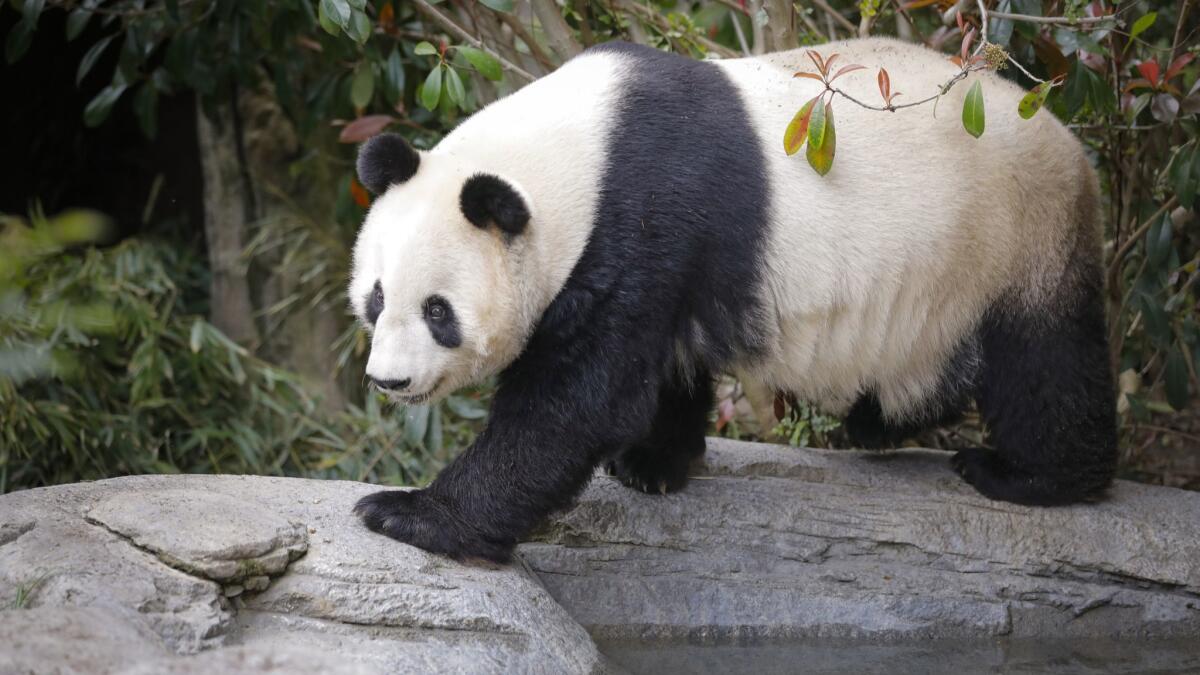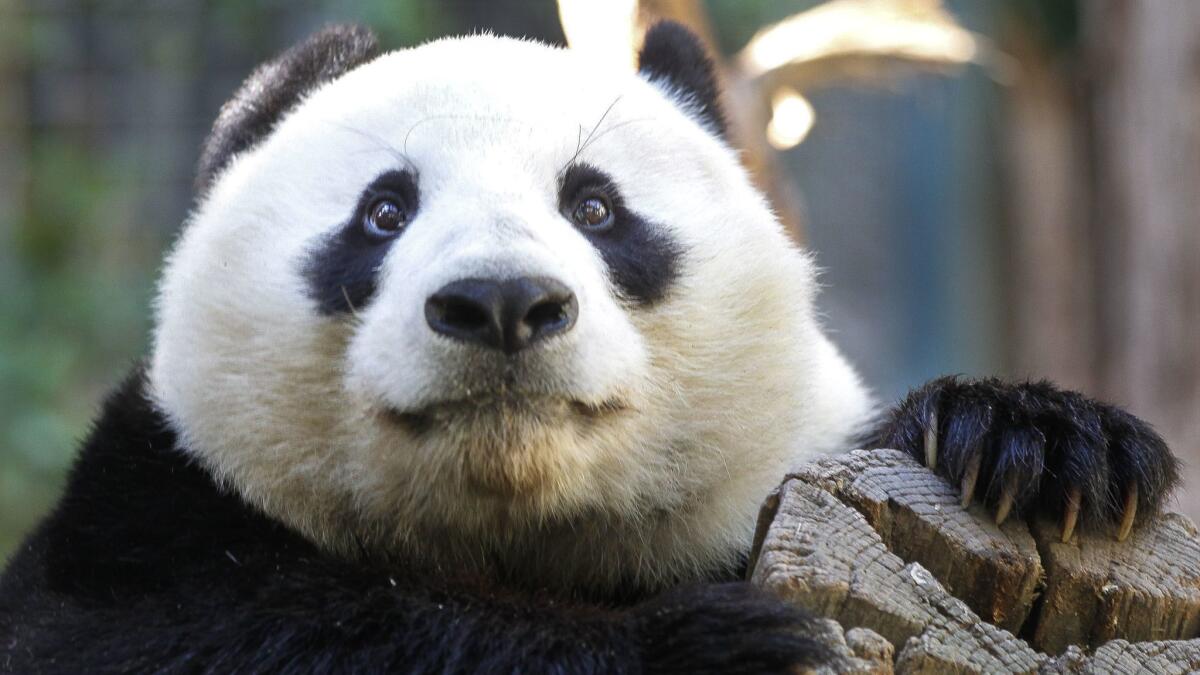Last pandas at San Diego Zoo are leaving for China

- Share via
It’s the end of an era at the San Diego Zoo as the last two giant pandas will soon leave for China.
In an announcement Monday, zoo officials said the pandas, Bai Yun, 27 — a fixture at the zoo for 23 years — and her son, Xiao Liwu, 6, would leave San Diego because a multiyear agreement with the Chinese had ended. Zoo officials said sending the pandas back was always planned for April and was not prompted by any sudden request from the Chinese government.
The iconic black-and-white bamboo eaters have had a consistent presence at the zoo since 1996. The last day pandas can be viewed by the public is expected to be April 27.
How the San Diego Zoo helped unlock the mystery of panda sex and parenting »
With their impending departure, it is unknown if or when new pandas might inhabit the zoo again. Zoo officials are unable to say whether the wait is a matter of months or years.
“We have high hopes for pandas returning, but I don’t know that we have any set date when they might return,” said Shawn Dixon, chief operating officer for the San Diego Zoo.
There are still pandas at Smithsonian’s National Zoo in Washington, D.C., Zoo Atlanta and the Memphis Zoo.
In the two decades since the first pandas arrived in San Diego, the animals have become intertwined with the image of the zoo. Their likenesses grace T-shirts and postcards promoting the region, and they had a featured role in the 2004 “Anchorman” movie. In the comedy, a San Diego news team chronicled the impending birth of a panda with the “Panda Watch.”
Although the prospect of no new pandas for the indefinite future might alarm fans, there is a promising sign: The zoo has no plans to take down the animals’ exhibit. And several zoo officials are planning to travel to China in the coming months for in-person negotiations with leaders of the country’s panda program.
The pandas’ departure may sadden the community, Dixon said, “but it’s a time for celebration. They are going home to their home country. It truly is a celebration of all the work we have done.”
The San Diego giant panda program has been very successful by most measures, producing six cubs and developing techniques now used around the world to keep young pandas alive. At the time pandas first came to the zoo in 1996, the International Union for Conservation of Nature listed the species as endangered. Within 20 years, their status had improved to “vulnerable.”
Two decades ago, the wild population of pandas was estimated to be less than 1,000. As of the latest count in 2014, there were 1,864 pandas living in the wild, according to the World Wildlife Fund.
Another panda at the zoo, 28-year-old Gao Gao, returned to China in October. Gao Gao and Bai Yun produced five cubs together, including Xiao Liwu. All three will be back together at the China Conservation and Research Center for the Giant Panda in Dujiangyan. Don’t expect much of a reunion — pandas are very solitary and aren’t expected to interact.
Pandas are only native to China, so all pandas in American zoos are on loan from the Chinese government. Even those born on American soil are considered property of China. It’s unclear from zoo officials what their negotiating strategy will be with the Chinese, or if whatever program comes next will involve breeding.

The species is the rarest of all bears and lives among damp bamboo forests in southwestern China. Most of the decline in numbers has largely been attributed to human encroachment, but pandas are also notoriously difficult to breed. They only mate one to two days a year, and successful pregnancies are rare.
It is unknown exactly when the pandas will leave. Bai Yun and her son Xiao Liwu will travel by plane and be attended to by numerous keepers and veterinarians. Bai Yun is expected to go into a retirement wing of the center, and Xiao Liwu will eventually be put in a breeding situation.
Zoo officials said it was bittersweet to say goodbye to the pandas but that they were proud of everything that was accomplished over 23 years.
“The intent was to prevent the extinction of the species. This program can be looked at as one of a handful of programs that have actually prevented the extension of a key species,” said Carmi Penny, director of husbandry sciences at the zoo.
Despite tension with the Chinese government and the Trump administration over tariffs, zoo officials say that sort of issue doesn’t filter down to those who are working with pandas.
A storied panda history
Giant pandas first took San Diego by storm in 1987 when two of the animals — Basi and Yuan Yuan — stayed for 200 days. The pandas were a sensation, drawing more than 2 million visitors, the zoo said.
A 1987 article in the San Diego Evening Tribune described their arrival as “a fanfare usually saved for humans” as news reporters, TV cameramen and zoo employees fawned over the pair. The price of a one-day adult ticket at the time was $8.50 and $2.50 for children. Now it is $56 for an adult and $46 for a child (ages 3 to 11).
Pandas did not return again until 1996, when Bai Yun and another panda, Shi Shi, arrived at the zoo from the Wolong Nature Reserve in China. Both were supposed to stay 12 years, although Bai Yun remained 13 years longer. The pandas, in special traveling crates, were loaded onto a moving truck and escorted by the California Highway Patrol to the zoo.
Things were rocky at first with Shi Shi, who was not interested in mating with Bai Yun. Bai Yun gave birth to her first panda, Hua Mei, in 1999 by artificial insemination. That panda became the first born in the United States to survive and grow into adulthood.
In 2003, Gao Gao showed up and quickly began a successful pairing with Bai Yun. A son, Mei Sheng, was born in 2003. Four other cubs followed: Su Lin in 2005, Zhen Zhen in 2007, Yun Zi in 2009 and the last, Xiao Liwu, in 2012.
Under the agreement with the Chinese government, most young pandas born in other countries are supposed to go back to China when they are around 3 years old. Xiao Liwu, though, has now stayed longer than expected, as has Bai Yun, who was allowed to remain because of how much success she had in breeding.
Bob Wiese, chief life sciences officer at San Diego Zoo, said several of the six cubs had gone on to have children of their own, building on a lineage originating in San Diego.
At the time the pandas were brought to the United States in 1996, the survival rate for cubs was 10% to 20%, Wiese said. Now, there is a 95% likelihood they will survive, he said, and part of that is because of work done at American zoos. One of those advances came from a San Diego Zoo nutritionist who developed a milk formula for cubs that is now in widespread use.
The formula is especially useful if the mother panda is not giving her cub enough milk. The milk that panda newborns need to survive is much more nutrient-dense than that of many species and is crucial for survival, making neglect by the mother potentially disastrous.
Xiao Liwu, star attraction
More than 100 people waited in line Friday to see Xiao Liwu on a cool 64-degree day. The line slowly snaked through the exhibit until the end, where adults and children crowded around the 6-year-old panda’s enclosure.
Xiao Liwu climbed around the tree-fort-style area and plopped down in one of his favorite spots to sit. A ray of sunshine illuminated the top of his head as he leaned back with a bamboo stalk. He put the stalk in his mouth and peeled off outer layers to begin his meal.
Visitors were squeezing against each other to see the panda, although he didn’t seem to notice.
“He’s right there,” yelled 6-year-old Brooklyn Putich, of Chino, as she finally got her first glimpse of the panda and climbed on the railing for a better look.
Families of young children made up much of the crowd, leading to the occasional baby-stroller traffic jam. Stephanie Toscano, of Tucson, Ariz., said she was in town for a wedding and decided to take her 4-year-old daughter, Adynn, to the zoo.
“She’s waited all day for this,” Toscano said. “She wouldn’t stop talking about it.”
Zoo officials said none of the staff that worked with the pandas would be laid off but would work with other animals. Still, it may be tough for those employees to say goodbye, especially to Bai Yun, the 23-year resident.
“She was the perfect panda,” said Penny, the husbandry director. “She was behaviorally stable, very intelligent, very inquisitive, not aggressive. Just a nice, good animal.”
Bai Yun was not on display for much of Friday, but no one seemed to notice with Xiao Liwu content to put on a show. He got up from his sitting spot, climbed across logs in the enclosure, grabbed another bamboo stalk, leaned back and started to chew again. Each movement was captured by dozens of smartphones.
Molnar and Bradley J. Fikes, who contributed to this report, work for the San Diego Union-Tribune.
More to Read
Sign up for Essential California
The most important California stories and recommendations in your inbox every morning.
You may occasionally receive promotional content from the Los Angeles Times.











